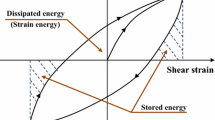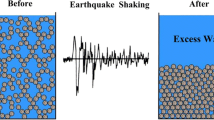Abstract
In the present study, minimax probability machine regression (MPMR) and extreme learning machine (ELM) have been adopted for prediction of seismic liquefaction of soil based on strain energy. Initial effective mean confining pressure (\( \sigma_{\text{mean}}^{\prime} \)), initial relative density after consolidation (D r), percentage of fines content (FC), coefficient of uniformity (C u), and mean grain size (D 50) have been taken as inputs of MPMR and ELM models. MPMR and ELM have been used as regression techniques. The performances of MPMR and ELM have been compared with the artificial neural network. A sensitivity analysis has been carried out to determine the effect of each input. The experimental results demonstrate that proposed methods are robust models for determination seismic liquefaction potential of soil based on strain energy.





Similar content being viewed by others
References
Agrawal G, Chameau JA, Bourdeau PL (1997) Assessing the liquefaction susceptibility at a site based on information from penetration testing. In: Kartam N, Flood I, Garrett JH (eds) Artificial neural networks for civil engineers: fundamentals and applications. ASCE, New York, pp 185–214
Ali HE, Najjar YM (1998) Neuronet-based approach for assessing liquefaction potential of soils. Transp Res Rec 1633:3–8
Andrus RD, Stokoe KH (1997) Liquefaction resistance based on shear wave velocity. In: Proceedings of the NCEER workshop on evaluation of liquefaction resistance of soils. National Center for Earthquake Engineering Research, State University of New York, Buffalo, pp 89–128
Balbay A, Avci E, Sahin O et al (2012) Modeling of drying process of bittim nuts (Pistacia terebinthus) in a fixed bed dryer system by using extreme learning machine. Int J Food Eng 8(4):10
Bazi Y, Alajlan N, Melgani F et al (2014) Differential evolution extreme learning machine for the classification of hyperspectral images. IEEE Geosci Remote Sens Lett 11(6):1066–1070
Baziar MH, Jafarian Y (2007) Assessment of liquefaction triggering using strain energy concept and ANN model capacity energy. Soil Dyn Earthq Eng 27:1056–1072
Berrill JB, Davis RO (1985) Energy dissipation and seismic liquefaction of sands: revised model. Soils Found 25(2):106–118
Goh ATC (1994) Seismic liquefaction potential assessed by neural networks. J Geotech Eng 120(9):1467–1480
Goh ATC (1996) Neural-network modeling of CPT seismic liquefaction data. J Geotech Eng 122(1):70–73
Goh ATC (2002) Probabilistic neural network for evaluating seismic liquefaction potential. Can Geotech J 39:219–232
Goh ATC, Goh SH (2007) Support vector machines: their use in geotechnical engineering as illustrated using seismic liquefaction data. Comput Geotech 34(5):410–421
Green RA (2001) Energy-based evaluation and remediation of liquefiable soils. PhD Dissertation, Virginia Polytechnic Institute and State University, Blacksburg
Hardy VA, Cheah YN (2013) Question classification using extreme learning machine on semantic features. J ICT Res Appl 7(1):36–58
Huang GB (2003) Learning capability and storage capacity of two hidden-layer Feedforward networks. IEEE Trans Neural Netw 14(2):274–281
Huang GB, Babri HA (1998) Upper bounds on the number of hidden neurons in feedforward networks with arbitrary bounded nonlinear activation functions. IEEE Trans Neural Netw 9(1):224–229
Huang GB, Siew CK (2004) Extreme learning machine: RBF network case. In: Proceedings of the eighth international conference on control, automation, robotics, and vision (ICARCV’04)
Huang GB, Siew CK (2005) Extreme learning machine with randomly assigned RBF kernels. Int J Inf Technol 11(1):16–24
Huang GB, Zhu QY, Siew CK (2004) Extreme learning machine: a new learning scheme of feedforward neural networks. In: Proceedings of the international joint conference on neural networks
Javadi AA, Rezania M, Mousavi Nezhad M (2006) Evaluation of liquefaction induced lateral displacements using genetic programming. Comput Geotech 33:222–233
Juang CH, Chen CJ (1999) CPT-based liquefaction evaluation using artificial neural networks. Comput Aided Civ Infrastruct Eng 14(3):221–229
Lanckriet GRG, Ghaoui LE, Bhattacharyya C et al (2002) A robust minimax approach to classification. J Mach Learn Res 3:555–582
Law KT, Cao YL, He GN (1990) An energy approach for assessing seismic liquefaction potential. Can Geotech J 27:320–329
Liang L, Figueroa JL, Saada AS (1995) Liquefaction under random loading: a unit energy approach. J Geotech Eng ASCE 121(GT11):776–781
Liong SY, Lim WH, Paudyal GN (2000) River stage forecasting in Bangladesh: neural network approach. J Comput Civ Eng 14(1):1–8
Liu Z (2005) Chaotic time series prediction based on MPMR. J Comput Inf Syst 1(4):733–739
Liu Z, Xie X, Zhang D (2006) Predict chaotic time series using minimax probability machine regression. Inf Technol J 5(3):529–533
Pal M (2006) Support vector machine-based modeling of seismic liquefaction potential. Int J Numer Anal Methods Geomech 30(10):983–996
Robertson PK, Campanella RG (1985) Liquefaction potential of sands using the CPT. J Geotech Eng 111:384–403
Samui P (2011) Least square support vector machine and relevance vector machine for evaluating seismic liquefaction potential using SPT. Nat Hazards 59(2):811–822
Samui P, Karthikeyan J (2013) Determination of liquefaction susceptibility of soil: a least square support vector machine approach. Int J Numer Anal Methods Geomech 37(9):1154–1161
Seed HB, Idriss IM (1967) Analysis of soil liquefaction: Niigata earthquake. J Soil Mech Found Div ASCE 93(3):83–108
Seed HB, Idriss IM (1971) Simplified procedure for evaluating soil liquefaction potential. J Soil Mech Found Div ASCE 97(9):1249–1273
Seed HB, Idriss IM, Arango I (1983) Evaluation of liquefaction potential using field performance data. J Geotech Eng Div ASCE 109(3):458–482
Seed HB, Tokimatsu K, Harder LF et al (1984) Influence of SPT procedures in soil liquefaction resistance evaluation. Report No. UCB/EERC-84/15. Earthquake Engineering Research Centre, University of California, Berkeley
Serre D (2002) Matrices: theory and applications. Springer, New York
Strohmann TR, Grudic GZ (2002) A Formulation for minimax probability machine regression. In: Dietterich TG, Becker S, Ghahramani Z (eds) Advances in neural information processing systems (NIPS) 14. MIT Press, Cambridge
Sun J, Bai Y, Luo J et al (2009) Modelling of a chaotic time series using a modified minimax probability machine regression. Chin J Phys 47(4):491–501
Yibin YE, Squartini S, Piazza F (2011) ELM-based algorithms for nonstationary Volterra system identification. Front Artif Intell Appl 234:77–84
Youd TL, Idriss IM, Andrus RD et al (2001) Liquefaction resistance of soils: summary report from the 1996 NCEER and 1998 NCEER/NSF workshops on evaluation of liquefaction resistance of soils. J Geotech Geoenviron Eng ASCE 127(10):817–833
Young Su K, Byung Tak K (2006) Use of artificial neural networks in the prediction of liquefaction resistance of sands. J Geotech Geoenviron Eng 132(11):1502–1504
Zhu Q, Qin AK, Suganthan PN et al (2005) Evolutionary extreme learning machine. Pattern Recogn 38(10):1759–1763
Author information
Authors and Affiliations
Corresponding author
Rights and permissions
About this article
Cite this article
Samui, P., Kim, D. & Hariharan, R. Determination of seismic liquefaction potential of soil based on strain energy concept. Environ Earth Sci 74, 5581–5585 (2015). https://doi.org/10.1007/s12665-015-4567-4
Received:
Accepted:
Published:
Issue Date:
DOI: https://doi.org/10.1007/s12665-015-4567-4




